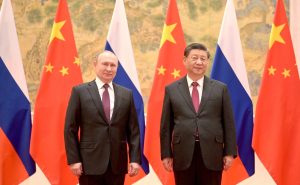Russian President Vladimir Putin was in Beijing for the inauguration of the Winter Olympics on February 4. While there, he also held significant discussions with Chinese leader Xi Jinping on a range of global issues. The lengthy 99-paragraph joint statement that followed their meeting details how Russia and China have come to adopt shared positions on several global and regional issues. The visit was significant since this was their first face-to-face meeting since 2019; Xi is not known to have traveled for any meetings with a foreign leader since the COVID-19 pandemic began in early 2020.
The pressure that both sides are facing from the United States and the West gives their partnership some depth. It is also worth noting that there are no significant immediate disagreements that could come in the way of this partnership. At the ideological level, both are authoritarian states that are trying to prevent the spread of liberal ideas of democracy and human rights, both at the domestic and international levels. In fact, this can be seen as a continuum, with the spread of liberal ideas globally potentially negatively affecting the elites of both countries: Putin and his kleptocratic cronies in the Kremlin as well as Xi and the Chinese Communist Party in Beijing. Not surprisingly, both countries have railed against liberal ideas, Putin by trying to undermine liberal democracies, including in the 2016 U.S. presidential election, and Chinese diplomats constantly criticizing these values and highlighting any deviation by its proponents.
While these values are important in cementing the ties between Russia and China, strategic conditions provide a more significant basis for this emerging partnership. Russia’s decline at the end of the Cold War left it insecure in Europe. Most of its former Warsaw Pact allies – countries like Poland, Hungary, Czechoslovakia (now Czechia and Slovakia), Romania, and Bulgaria – as well as the three former Soviet Baltic States – Lithuania, Latvia, and Estonia – have all become members of NATO. But as the Russian economy and its power grew over the last two decades, Moscow has increasingly railed against the conditions that it faces in Central Europe. Putin also had some success in Georgia in 2008 and Crimea in 2014 as well as the intervention in Syria. Russia would like a buffer to its west, and the threat of Ukraine slipping away from Russia’s grasp appears to have been a significant motivator for Moscow’s current aggressive posturing. But it is also clear that any Russian action will unite the West, thus necessitating a powerful ally like Xi’s China.
Similar factors work for China also. Under Xi, China has become much less concerned about demonstrating a “peaceful rise” and much more keen to demonstrate that it has already risen. China is now economically an equal to the United States and its manufacturing power as well as its integration with the global economy gives China enormous clout. China has not been shy about using that clout to repeatedly engage in trade coercion against other states including Australia, South Korea, and Japan. China now demands parity in status with the United States, something that Beijing believes it is not getting. Like Russia, China sees the United States as an obstacle to its goals — in China’s case, its desire for dominance in Asia to begin with. It is thus not surprising that these two powers would make common cause in countering the U.S. and the West.
The joint statement reflects the mutual support between these powers. Russia must be very pleased with China’s support for Russian proposals “to create long-term legally binding security guarantees in Europe.” Even as the joint statement is silent on Ukraine, China has extended clear support to Russian thinking that both sides “oppose further enlargement of NATO and call on the North Atlantic Alliance to abandon its ideologized cold war approaches, to respect the sovereignty, security and interests of other countries.” Just as China supports Russian objectives with regard to NATO expansion, Russia supports China’s view of the Indo-Pacific and the illegitimacy of the U.S. role there. The joint statement, for instance, says that the two countries are “against the formation of closed bloc structures and opposing camps in the Asia-Pacific region and remain highly vigilant about the negative impact of the United States’ Indo-Pacific strategy on peace and stability in the region.”
The joint statement also criticizes ideas of democracy that both Russia and China see as imposed by the United States and the West. According to the joint statement, Russia and China “share the understanding that democracy is a universal human value, rather than a privilege of a limited number of States.” The statement further added that “There is no one-size-fits-all template to guide countries in establishing democracy” and that it is up to the individual nations to “choose” the different “forms and methods of implementing democracy that would best suit its particular state,” depending on a number of local conditions including social and historical background as well as “unique cultural characteristics.”
None of this suggests a formal military alliance; nevertheless, the statement does say that “the new inter-State relations between Russia and China are superior to political and military alliances of the Cold War era,” and that the “friendship between the two States has no limits, there are no ‘forbidden’ areas of cooperation, strengthening of bilateral strategic cooperation is neither aimed against third countries nor affected by the changing international environment and circumstantial changes in third countries.”
Necessity is clearly pushing Russia and China together, but it remains to be seen how long it will last.

































